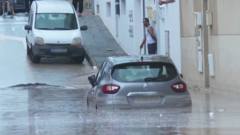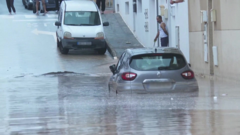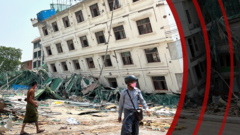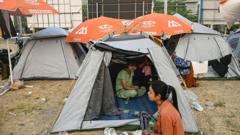In the past two weeks, Santorini and nearby islands have experienced an alarming series of earthquakes, the latest being a 5.3 magnitude tremor. As authorities enforce safety protocols and residents remain vigilant, many tourists have fled, casting uncertainty over the tourism season in this popular destination.
Santorini Faces Wave of Earthquakes Amid Heightened Caution
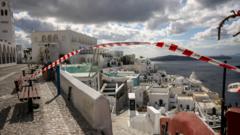
Santorini Faces Wave of Earthquakes Amid Heightened Caution
Thousands of minor quakes have struck the beloved tourist destination of Santorini, prompting safety measures and a state of emergency.
Santorini is reeling from a significant surge in seismic activity, culminating in a powerful earthquake measuring 5.3 on the Richter scale. This recent quake, occurring at a shallow depth of 17 kilometers, is the most intense of the numerous tremors the island has experienced in recent weeks, leading to heightened concerns among residents and tourists alike.
The seismic unrest has affected surrounding islands, including Amorgos, which remains on alert after multiple quakes struck. Since January, the area has recorded over 12,800 earthquakes, prompting the University of Athens' Seismological Laboratory to keep a close watch on developments. The latest tremors, including a 5.0 magnitude quake on Sunday, have led to residents proactively safeguarding precarious tourist spots, deterring visitors from doing photo shoots near cliffs.
Frequent landslides have arisen from the continuous shaking, heightening anxiety around the potential for a significant earthquake in the region. While experts had earlier expressed hope that the tremors were beginning to ease, concern is rising that their intensity may be escalating instead. A state of emergency is now in effect on the island through March 3.
Despite the alarming frequency of quakes, inspections have reported no structural damage across Santorini or Amorgos, nor any injuries linked to the recent seismic events. Nevertheless, the ongoing unrest has driven over 11,000 individuals to evacuate the islands. As a precaution, local schools are closed for Monday and Tuesday.
In response to the ongoing situation, a Special Disaster Response Unit has been dispatched from Patras to Amorgos, equipped with specialized equipment to address potential earthquake-related incidents, while technical teams are evaluating the local electricity infrastructure.
According to Kostas Papazachos, seismology expert from Aristotle University of Thessaloniki, patience is required as authorities prepare for the likelihood of tremors to persist beyond February. His cautious optimism is tempered by the reality that the risk of a more significant earthquake remains.
As the tourism industry braced for potential impacts, the cruise ship Viking Star, carrying a significant number of passengers and crew, opted for a detour to Crete, avoiding the crowded Santorini port during the ongoing seismic crisis. It's worth noting that Greece, situated on the Hellenic Volcanic Arc, is a region well-known for its seismic activity, but scientists continue to be puzzled by the current cluster of earthquakes, which appear unrelated to volcanic activity, with tectonic plate movements cited as a primary cause.



